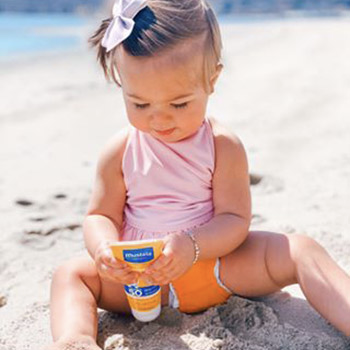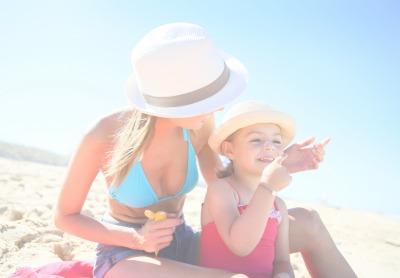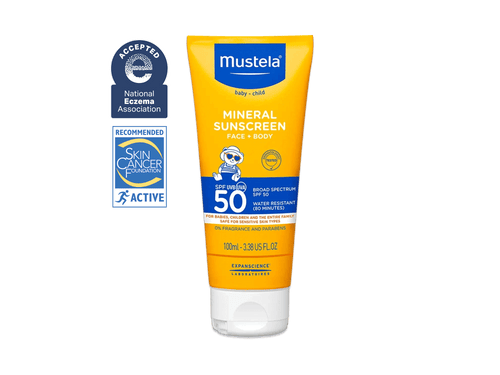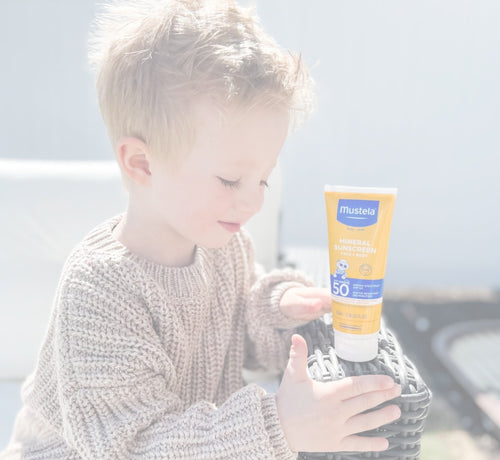We all understand the dangers of the sun. It’s no secret that prolonged exposure to UV rays leads to sunburn and increases the risk of skin cancer. It’s also common knowledge that protecting your baby’s skin with sunscreen is especially important.
But did you know that many sunscreens contain chemical ingredients that may have adverse health effects for you and your little one?
In this article, the baby experts at Mustela will give you an in-depth look at mineral vs. chemical sunscreen. Along the way, we’ll answer the following questions:
- What is the difference between mineral and chemical sunscreen?
- What is a chemical sunscreen?
- Are chemical sunscreens safe for babies?
- What is a mineral sunscreen?
- Are mineral sunscreens safe for babies?
We know that your baby’s well-being is priority number one, so we’ll give you all the information you need to keep your little one safe in the sun.
How Do Sunscreens Work?

The sun emits ultraviolet (UV) rays. And as much as you love feeling the sun’s warmth, these UV rays can cause all kinds of skin damage. There are two types of UV rays that can hurt your (and your baby’s!) skin: UVA and UVB.
UVA
UVA rays (ultraviolet A) are long waves from the sun that penetrate deep into your and your baby’s skin and create long-term effects. We’re talking things like wrinkling, age spots, and cancer.
Obviously, your baby won’t be too worried about wrinkling and age spots, but you can set them up for healthy skin habits early on!
UVB
UVB rays (ultraviolet B) are shorter waves from the sun that only reach the surface of your baby’s skin. This is what causes tanning or sunburn.
According to the University of Iowa Health Care (UIHC), there are approximately 500 times more UVA rays in the sun’s light than UVB rays! So not only do you need to protect your baby from the effects of UVB rays, but you also need to protect them from the damaging effects of abundant UVA rays.
To do that, you’ll need to lather your baby up with sunscreen. But how do sunscreens work, exactly?
We’ll let you in on a little secret. The sunscreen you’re using contains either mineral or chemical filters. Chemical filters absorb the UV rays, while mineral filters act as a physical barrier on your skin.
(Read below to find out more about chemical and mineral sunscreens!)
What Is SPF?

SPF stands for Sun Protection Factor. This is the number that you’ll see on the side of your sunscreen bottle, like SPF 30, for example. SPF is a measure of your sunscreen's ability to protect against UVB rays and their damaging effects.
According to the Skin Cancer Foundation, the SPF number tells you how long the sun’s UVB rays would take to redden your skin if you applied the sunscreen exactly as directed compared with the amount of time without sunscreen.
In other words, if you used an SPF 30 product properly, it would take 30 times longer for you to burn than if you used no sunscreen.
But what about those UVA rays we mentioned earlier? Unfortunately, many sunscreens do not protect against UVA rays. (Remember: these are the rays that can penetrate deep into your and your baby’s skin!)
To guarantee protection against UVA and UVB rays — both of which can cause cancer — choose a sunscreen with a “Broad Spectrum” label. This is the best way to protect your baby’s skin!
What Is The Difference Between Mineral And Chemical Sunscreen?

The main difference between chemical and mineral sunscreens can be found in their ingredient lists.
Chemical sunscreens have ingredients that may potentially cause health problems for you and your baby. Mineral sunscreens, on the other hand, use two natural minerals—zinc oxide and titanium dioxide—as active ingredients. These minerals simply sit on top of your skin and protect it by reflecting away UV rays.
To better understand the differences between chemical and mineral sunscreens, let’s take a closer look at each.
What Is A Chemical Sunscreen?

A chemical sunscreen is one whose active ingredients are non-natural, chemical compounds. Here are a few examples of chemical ingredients commonly found in sunscreen:
- Oxybenzone
- Avobenzone
- Octinoxate
- Homosalate
- Octisalate
- Octocrylene
Despite the fact that these compounds have all been approved by the Food and Drug Administration (FDA), research shows potential risks for several of them, including:
- Octinoxate
- Oxybenzone
- Octocrylene
- Padimate O
The active ingredients in chemical sunscreens, like the ones listed above, are effective because they absorb the sun’s UV rays. Then, through a chemical reaction, the sunscreen dissipates the UV rays. This means that your skin is protected because the UV rays never actually hit your body.
However, before these chemicals can offer any UV protection, your skin has to absorb them. This can cause irritation and discomfort, especially for children with sensitive skin.
Additionally, trace amounts of the chemicals found in chemical sunscreens can trickle into your bloodstream. Once in your bloodstream, they can filter into other bodily fluids, such as breastmilk.
A study published by a team of scientists, led by Dr. Margret Schlumpf of the University of Zurich, found trace amounts of at least one sunscreen chemical in the breast milk of 76.5 percent of the women they tested.
Octinoxate was detected in a whopping 64.7 percent of the sampled women’s breast milk. Three other FDA-approved sunscreen chemicals—oxybenzone, octocrylene, and padimate O—were also found in significant amounts. This raises serious questions about breastfeeding safety.
At this point, you must be wondering whether or not these chemicals are safe for your baby. Let’s address that concern now.
Are Chemical Sunscreens Safe For Babies?

As we discussed in the previous section, the active ingredients in chemical sunscreens often seep into your bloodstream. What happens then? Some of the compounds can affect the hormone levels in your body.
For example, studies show that chemical ingredients in sunscreens can increase the risk of endometriosis in women, decrease sperm concentration in men, and lower testosterone levels in adolescent males.
If research found that these chemical compounds might negatively affect your health, why did the FDA approve them? The short explanation is that the FDA approved these chemicals when they first began regulating sunscreen in the late 1970s.
At that time, most of these chemicals had already been used in sunscreens for years. As such, they were approved without having to go through the strict approval process. In other words, they were grandfathered in.
Although recent research suggests that some of these chemicals are potentially harmful, the research is not yet conclusive. Scientists are still trying to understand the effects of the ingredients in chemical sunscreens.
The FDA would need unquestionable evidence in order to reverse its approval and ban any single chemical from being used in sunscreens. That’s why they remain on the market today.
So, given the above information, are chemical sunscreens safe for babies? Unfortunately, we simply don’t know if chemical sunscreens are safe for young children.
In fact, we aren’t even sure that they’re safe for adults! More research is necessary before we can draw any definitive conclusions.
But to give you a better idea of potential safety hazards, we’ll look at the pros and cons of chemical sunscreen so you can properly weigh your options.
Pros Of Chemical Sunscreen
- Doesn’t leave residue on your baby’s skin
- Less is needed to protect your baby’s skin
- Spreads easily onto your baby’s skin
Cons Of Chemical Sunscreen
- Increases your baby’s chance of having a reaction and irritates the skin
- Takes 20 to 30 minutes to absorb into your baby’s skin
- Needs to be reapplied more frequently
All of this might sound concerning, but don’t worry! There’s a safer option available for protecting your little one’s skin from the sun: mineral sunscreen. Simply put, mineral sunscreens are safer alternatives to their chemical cousins.
What Is A Mineral Sunscreen?

A mineral sunscreen is just what it sounds like—a sunscreen that uses minerals as its active ingredients. The minerals most often used are zinc oxide and titanium dioxide. Both of these ingredients occur naturally, although they can also be created synthetically.
Mineral sunscreens work in a completely different way than chemical sunscreens. Remember, chemical sunscreens penetrate your skin and offer protection by dissipating UV rays. By contrast, mineral sunscreens simply sit on top of your skin and reflect UV rays away from your body.
Mineral sunscreens are sometimes called physical sunscreens because they provide a physical barrier between your skin and the sun’s rays. Think of these minerals as millions of tiny mirrors resting on the surface of your skin, bouncing away harmful UV rays.
Are Mineral Sunscreens Safe For Babies?
Sunscreens that contain only mineral-based active ingredients are safe to use on babies. This is indisputable.
The only thing to keep an eye out for is sunscreens that use both mineral and chemical ingredients. These sunscreens might advertise themselves as mineral sunscreens but may have chemical ingredients, too.
As always, read the label and check the ingredients before putting any products on your baby’s skin.
If you’re looking for a sunscreen that’s safe for your child, try Mustela SPF 50 Mineral Sunscreen Lotion. It has 100 percent mineral-based active ingredients that offer superior protection from UV rays.
On top of that, the natural ingredients won’t irritate your baby’s delicate skin. Why take chances with a chemical sunscreen when there are safe, effective options already available?

What Does Non-Nano Mean?
Why are some mineral sunscreens being marketed as “non-nano?” Some corporations that manufacture chemical sunscreens have suggested that mineral sunscreens can also be absorbed by your little one’s skin.
These companies claim that since the ingredients in mineral sunscreens are broken down into tiny pieces (called nanoparticles), they can easily seep into your baby’s skin cells.
However, this claim contradicts the findings of the international scientific community. A 2009 report published by the Australian Department of Health reviewed all major studies of zinc oxide and titanium dioxide. The conclusion was stated plainly:
“To date, the current weight of evidence suggests that TiO2 [titanium dioxide] and ZnO [zinc oxide] nanoparticles do not reach viable skin cells, rather, they remain on the surface of the skin and in the outer layer (stratum corneum) of the skin.”
That’s good news! But here’s the even better news: many sunscreen companies, like Mustela, have decided not to take any risks with nanoparticles and skin absorption. Your family is just too precious!
So, just to be on the safe side, our sunscreen is made with non-nano particles.A non-nano particle is bigger than a nanoparticle, which means it won’t seep into skin cells or your bloodstream.
That’s why we’ve chosen non-nano zinc oxide for our SPF 50 Mineral Sunscreen Lotion Family Size, SPF 30 Mineral Sunscreen Spray, and SPF 50 Mineral Sunscreen Lotion.
That being said, this is one case where the science is clear. Non-nano mineral sunscreens are the safest option for protecting your precious baby from the sun!
Even so, you’ll want to weigh the pros and cons of mineral sunscreens as well. We hope you’ll notice the benefits of the pros outweigh the cons and they far exceed any pros of chemical sunscreens!
Pros Of Mineral Sunscreen
- Safe and effective ingredients
- Ideal for children
- Ideal for those with sensitive skin
- Offers immediate protection
- Naturally broad-spectrum (offers protection against both UVA and UVB rays)
- Lasts longer in direct UV light
Cons Of Mineral Sunscreen
- May feel heavy on your baby’s skin at first
- May be difficult to fully blend into your baby’s skin
- Can rub off, sweat off, and rinse off easily (doesn’t last as long when wet or sweaty)
Mineral vs. Chemical Sunscreen: Additional Facts To Consider

In addition to the ingredients in mineral and chemical sunscreen, there are a few other factors to consider before deciding on a specific product.
First, some mineral sunscreens may leave a slight residue on your baby’s body since the minerals are not actually absorbed into their skin. Chemical sunscreens include ingredients called penetration enhancers, which help the chemicals make their way into your child’s skin.
This makes it easier for chemical sunscreen to be rubbed in smoothly and transparently. But remember—you don’t want your baby’s skin absorbing these harmful chemicals! The fact that mineral sunscreen may leave residue behind is just further evidence that they’re safer for you and your little one.
Sun Safety Tips

Soaking up the sun’s rays is important for a healthy body. We actually get natural Vitamin D from the sun. A couple of fun facts about Vitamin D: it promotes healthy bone growth, and it’s a natural immune-system booster!
So, we’re not saying to stay out of the sun completely. We’re saying protect your baby while they’re in the sun. Most of us don’t wear enough sunscreen, babies included. If your baby is six months or older, you need to apply sunscreen to their skin daily!
Think about it: how many times do you step outside with your baby, especially during the spring and summer months?
You take your baby for a walk in their stroller. You sit outside with your baby rocking in your chair. Your baby rides in the car in their car seat that’s right next to the window.
Your little one is exposed to the sun more than you realize, which is why it’s important to apply sunscreen daily.
Choose A Mineral Sunscreen
After reading the first part of this article, you can probably see the benefits of choosing a mineral sunscreen, like our SPF 50 Mineral Sunscreen Lotion that we mentioned above. Remember it provides safe and effective daily sun protection for babies, children, and the entire family.
Our mineral sunscreen is also:
- Fragrance-free
- Water-resistant for up to 80 minutes
- Compliant with Hawaii’s sunscreen ingredient requirements
Note: Pay attention to the expiration date on your baby’s sunscreen. If the product is expired, it may not be as effective.
Find Shade
In addition to using a good broad-spectrum mineral sunscreen, avoid letting your baby linger directly in the sun for a long time. Sit your baby under an umbrella or tree to protect them from direct exposure to the sun.
Also, when you’re out for a walk, use the sunshade provided with your baby’s stroller to protect their delicate skin.
Give Your Baby A Hat
Not only will your baby look extremely cute wearing a hat, but it will also protect their face, eyes, ears, and the back of their neck from the sun. Be sure to choose a hat that covers these areas and fits correctly on your baby.
Have Fun In The Sun

When choosing a sunscreen, consider going with a mineral version and make sure that it’s labeled “broad spectrum.” These two factors can give you and your little one safe, effective sun protection all year long!
Mustela's SPF 50 Mineral Sunscreen Lotion is the best option for a broad-spectrum, 100 percent mineral-based sunscreen for your whole family!
We all know that the sun can damage our skin. But don’t let that stop you from enjoying the great outdoors with your baby! With a safe, broad-spectrum mineral sunscreen, you can have fun in the sun with peace of mind.









